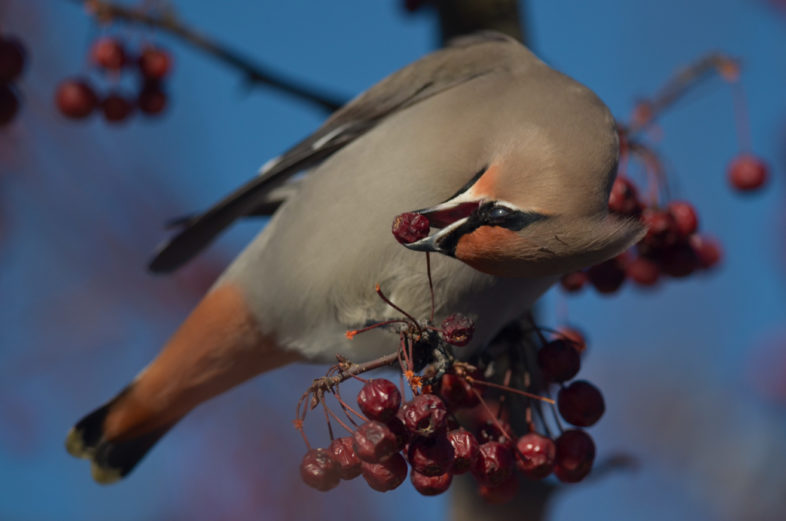
Bohemian Waxwing feeding on crabapples © Nathaniel Sharp
By Nathaniel Sharp and Kent McFarland
This month, wildlife and the rest of us here in New England will cross a threshold – arbitrary yet not insignificant: 10 hours of daylight. You can sense it when you head out in the morning: Northern Cardinals, House Finches, and Black-capped Chickadees are among the birds breaking out into song, and Hairy and Downy Woodpeckers are starting to drum. Even though we’ve got lots more winter, at least the sound of spring is in the air. So here’s a Field Guide to February to help get your hopes up, no matter what that sleepy woodchuck predicts.
The Howl of Winter
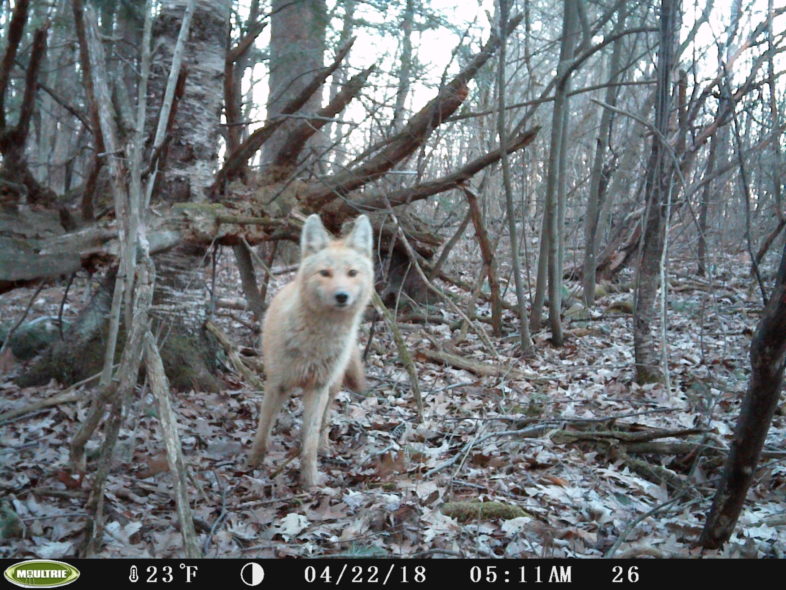
Coyote eyeing a motion-sensing camera
Eastern Coyote breeding season peaks now – around the middle of February. The howl of coyotes can usually be heard on winter nights, especially during mating season. They usually begin breeding at two years of age and may mate for life. The gestation period is approximately nine weeks, with an average litter of six pups. The Eastern Coyote is an opportunistic omnivore. It is both a predator and a scavenger, with a widely varied diet. They’ll eat small rodents, plants, fruit, deer, Snowshoe Hare, Cottontail Rabbits, insects, birds, and even a Woodchuck.
Add your sightings to the Vermont Atlas of Life on iNaturalist and see where others have heard or seen them too.
Coyote? Eastern Coyote? Coy-dog? Coy-wolf? What is this canine? Learn more about its name and natural history from the VPR podcast – A Brave Little State.
Spring Migrants & Winter Visitors
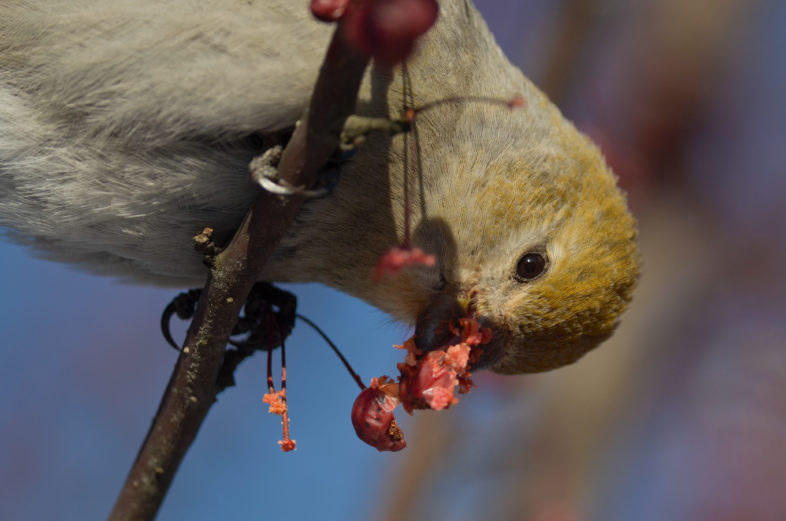
Pine Grosbeak feeding on crabapples © Nathaniel Sharp
Pick your favorite sign of spring: squirrels mating, mud oozing, maples flowering. We like a vulture soaring. Although hardly a long-distance migrant, Turkey Vultures are among the first northbound birds we see (view live eBird map) in northern New England each February. We hope you’ll add your sightings to Vermont eBird. And, check out the eBird bar chart to find out what might be arriving each week this spring and click on a species of interest to see a chart like this one for Turkey Vulture.
As the first Turkey Vultures and Red-winged Blackbirds of spring begin to trickle in from the south, we still have some lingering northern visitors remaining around Vermont well into February. Irruptive species like Pine Grosbeaks and Bohemian Waxwings have been turning up all over Vermont lately, and can be found wherever fruiting trees are plentiful. We have even been lucky enough here at the Vermont Center for Ecostudies to have crab apple trees full of fruit (and therefore, fruit-eating birds) right across from our headquarters in Norwich.
From fruit trees to farms and fields, there are many birds that take their winter vacation down to the relative warmth of Vermont. While driving along rural Vermont roads, it is wise to be on the lookout for “snow flurries” of white birds along the roadway, as this is the best way to find Snow Buntings and the other species they associate with, Horned Larks and Lapland Longspurs.
Visit Vermont eBird to track recent sightings, plan your next birding trip, or simply marvel at gorgeous photos of all these species and more.
Stories in the Snow
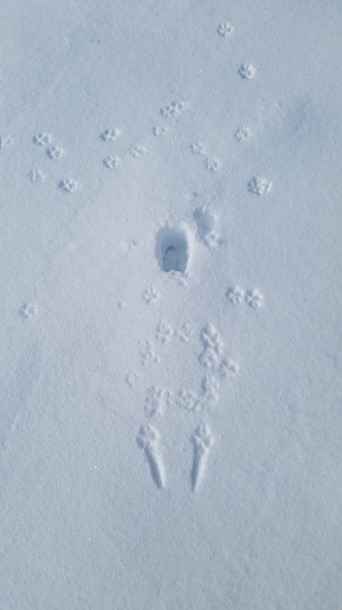
Tracks of a Gray Fox hunting in snow © Sophie Mazowita
A snowy winter may be bad news for your commute to work, but it is great news when it comes to animal tracking. Anywhere from a light dusting to a few inches of snow on the ground can reveal the travels of squirrels, foxes, fishers, and numerous other animals through the woods and even right through your backyard! Animal trails can tell all kinds of stories, and following them in the snow can reveal interesting behaviors, raise new questions, and help you learn about how animals navigate the landscape, whether you know exactly what species’ tracks you’re looking at or not.
iNaturalist can help you narrow down the ID of those footprints in the snow with the help of advanced software and a massive network of tracking experts ready to lend a hand. Submit your observations of animal tracks and trails to the Vermont Atlas of Life on iNaturalist, and be sure to include something like a coin, ruler, or key in the photo as a size reference.
Playing ‘Possum
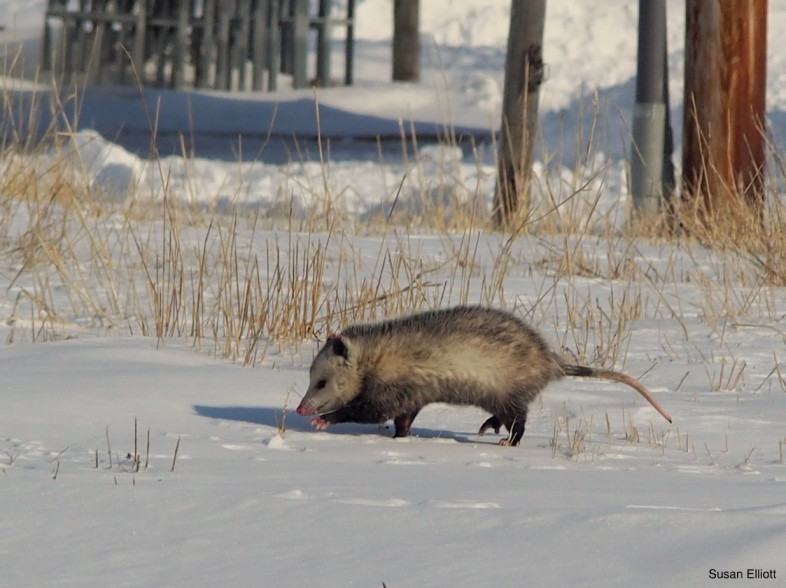
Virginia Opossum in Addison. / © Susan Elliott.
The Virginia Opossum has its first litter of 5-13 young in February. The young are about the size of a bumble bee at birth, only one-fifth of a gram. As soon as they are born they crawl, blind, into the female’s pouch and begin to nurse. After 60 days of pouch life, they crawl out and may be carried on her back. When they are about 100 days old, they are on their own.
With thin fur coats and naked tail, ears, and long snout, opossums are not well adapted to a cold northern winter. Many show signs of frostbite. Yet, they have been marching slowly northward in overall distribution for decades. The first opossum was reported in Burlington in 1988. By 1995, they had reached Montreal.
“They are very opportunistic, and my guess is that global warming has something to do with pushing them farther north,” University of Vermont mammalogist Bill Kirkpatrick told the Burlington Free Press in 2000.
You can help track their range by posting your sightings of live or road-killed opossums to iNaturalist Vermont. Meanwhile, check out the latest sightings reported from around the state.
Signs of Spring(tails)
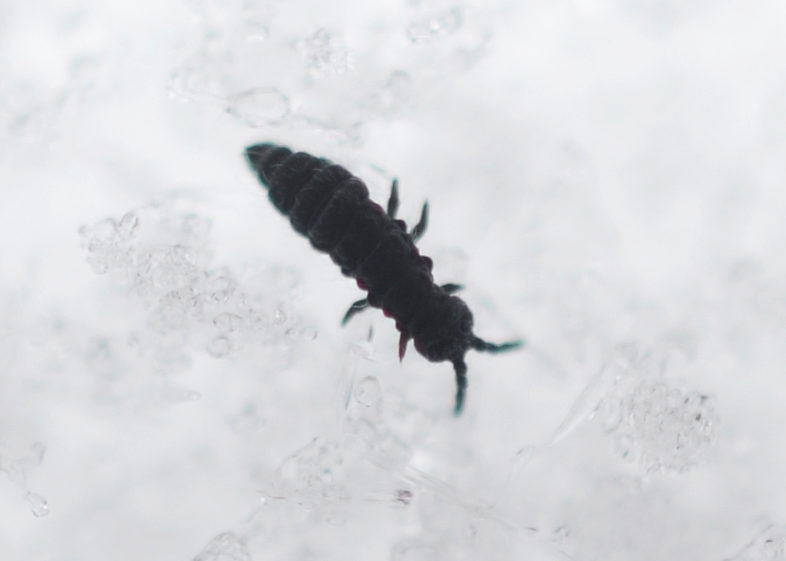
© Larry Clarfeld
Winter springtails, also known colloquially as snow fleas, are a group of arthropods in the genus Hypogastrura. While six-legged, they are not technically insects, and are in fact more closely related to crustaceans.
These little critters are all around us on the forest floor year round, helping decompose organic matter in the leaf litter, but are most visible in late winter. Punctuating the snow, their small blue-gray bodies first appear to be small specks of dirt, but upon closer inspection a whole community of often hundreds is revealed. While walking through the woods on sunny February days when the temps hover around or above freezing, don’t forget to look down at your feet and admire these tiny harbingers of warmer days to come.
There have even been new species to science discovered here in Vermont! In 2011 Felipe N. Soto-Adames and Rosanna Giordano described three new species of springtails. Bellisotoma joycei and Scutisotoma champi (named after the mythical lake monster Champ) were collected in sandy beaches along Lake Champlain, and Ballistura rossi was found only in a constructed wetland built and managed by the University of Vermont. Two of the species and a new genus (Bellisotoma) were dedicated to Ross Bell and Joyce Bell, UVM Emeritus Professors of Biology, in celebration of their contributions to the study of the entomological fauna of Vermont.
Submit your sightings of snow fleas to the Vermont Atlas of Life on iNaturalist, and if you would like to learn more about the fascinating relationship these little hexapods have with fungi and eastern white pines, check out the “Meat Eating Trees” section in our Field Guide to June 2016.

I work at the Comfort Inn in White River Junction, Vermont. Outside my window is a large tree that has red buds/berries on it. This afternoon, a large flock of birds has been gathering in and around this tree and other similar trees in our parking lot. I did a little research and wonder if these might be Grosbeaks. Seem to have light yellow breasts, black wings and a hint of rose around the head. Any thoughts on what they might be?
NIce observation! Sure sounds like Pine Grosbeaks! If you can get a photo, even an average shot, post it to our neat project called the Vermont Atlas of Life at iNaturalist.There’s even a free smartphone app for it! Or, drop an image here and I can take a look. https://www.inaturalist.org/projects/vermont-atlas-of-life